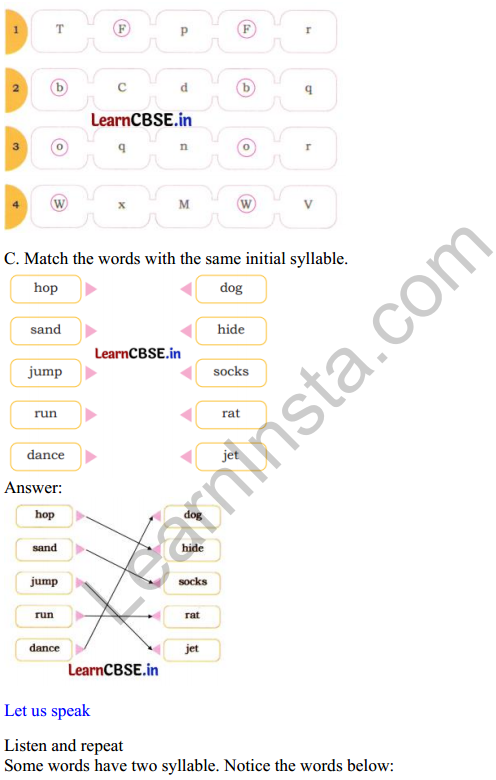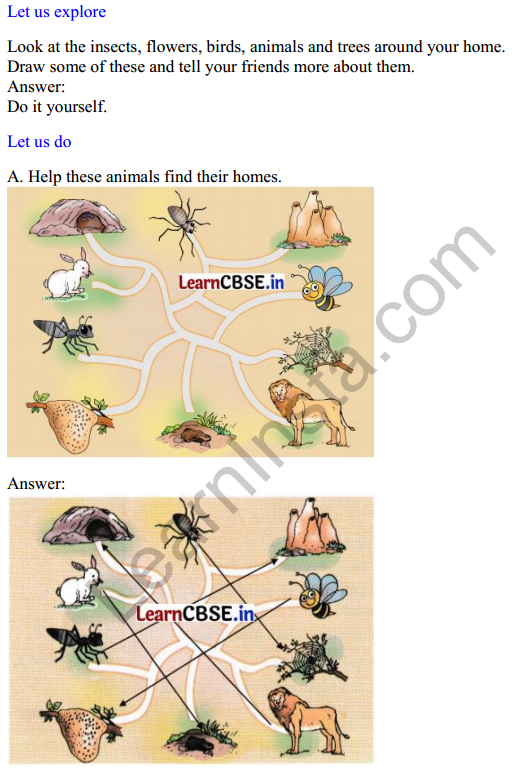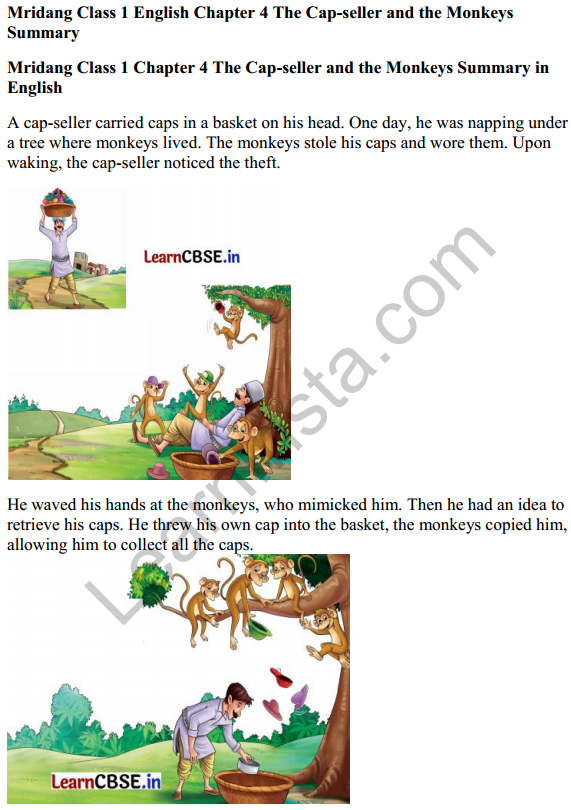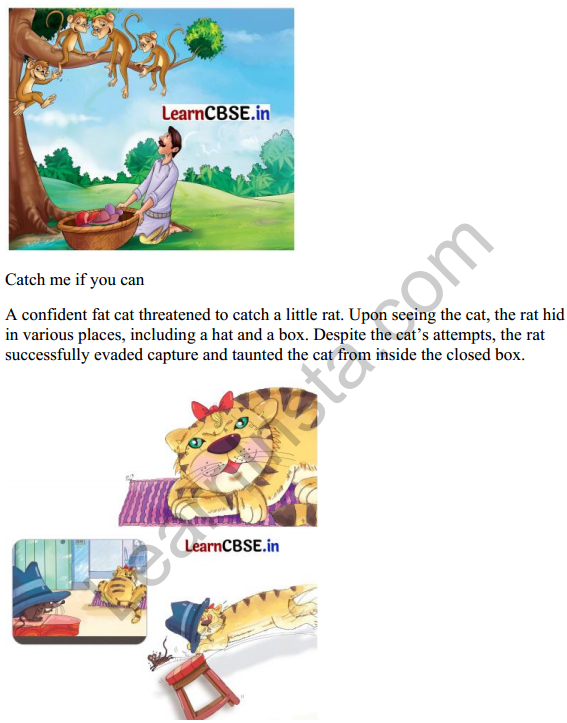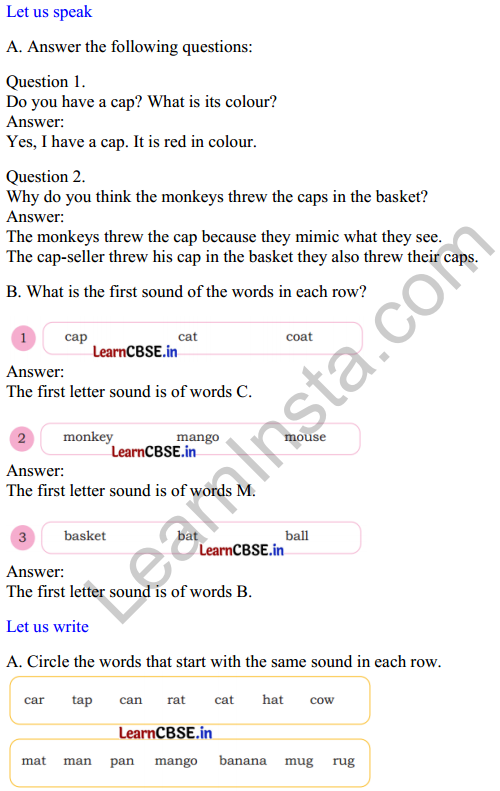Class 1 English Chapter 4 The Cap-seller and the Monkeys Question Answer
The Cap-seller and the Monkeys Question Answer Class 1
Let us speak
A. Answer the following questions.
Question 1.
Do you have a cap? What is its colour?
Answer:
Sample Answer: yes, red.
Question 2.
Why do you think the monkeys threw the caps in the basket?
Answer:
Actually, the monkeys were in the habit of copying a man. So when the cap-seller threw his cap into the empty basket, the monkeys also copied his action and threw their caps into the basket.
![]()
B. What is the first sound of the words in each row?

Answer:
- ca, co
- mon, ma, mo
- ba
Let us write
A. Circle the words that start with the same sound in each row.

Answer:

B. Write the numbers (1-4) next to the pictures according to the story.
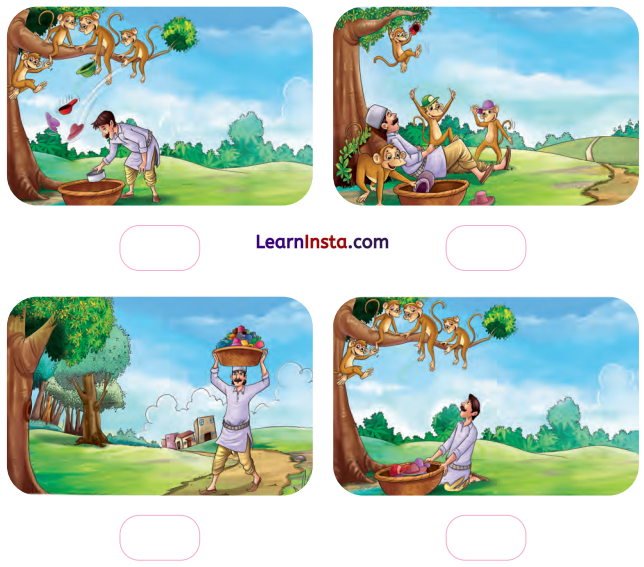
Answer:

C. Let’s colour and write.
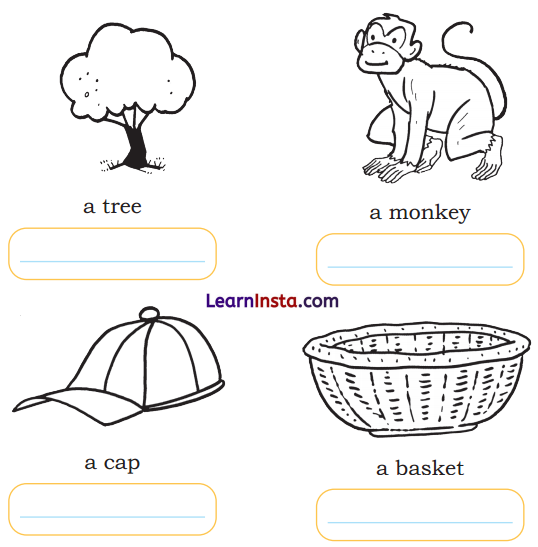
Answer:

D. Cats, rats, ants and more! Write their names.


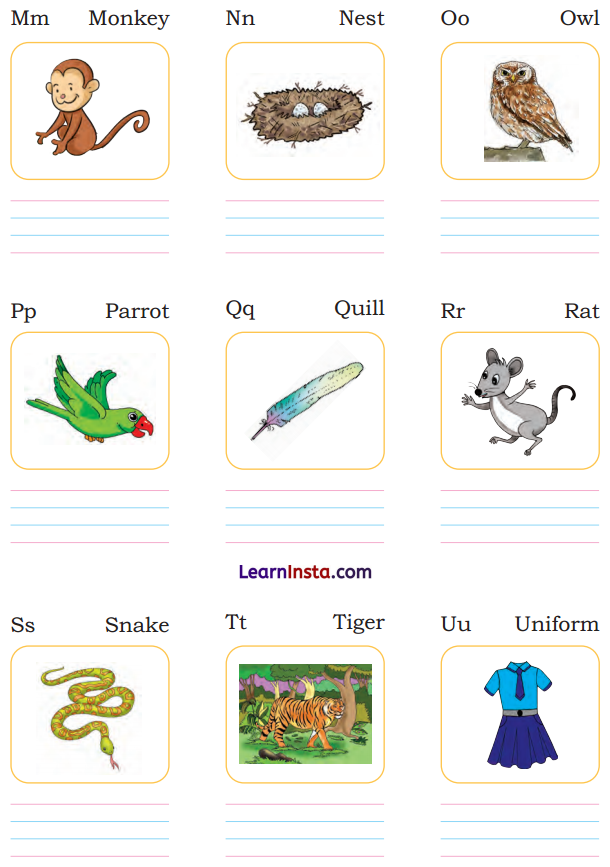

Answer:
Trace on their names.




Let us sing
Butterfles
Butterfles, butterfles,
Up, up, up.
Butterfles, butterfles,
Down, down, down.
Butterfles, butterfles,
In, in, in.
Butterfles, butterfles,
Out, out, out.
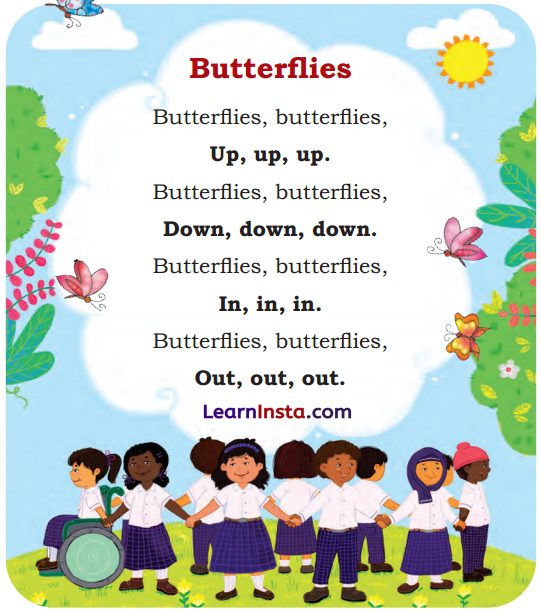
Would you like to replace butterflies with anything else? Try.
Answer:
Sing the poem aloud.
![]()
Let us speak
A. Answer the questions.
Teacher: Look up! What do you see on the tree?
Child: I see _____________ on the tree.
Teacher: Look down! What do you see on the ground?
Child: I see ____________________ on the ground.
Teacher: Look up! What do you see in the sky?
Child: I see _____________ in the sky.

Answer:
Teacher: Look up! What do you see on the tree?
Child: I see a monkey, a kite, a beehive, two birds, a nest, bees, and mangoes on the tree.
Teacher: Look down! What do you see on the ground?
Child: I see a rabbit, a squirrel, a stream, a cow and a house on the ground.
Teacher: Look up! What do you see in the sky?
Child: I see two birds and an aeroplane are in the sky.
B. Say and Clap
Say aloud each line of both the poems, clapping for every word. For example

Answer:
Read aloud and clap after every word.
Let us write
A. Encircle the words that have ‘p’ in them.
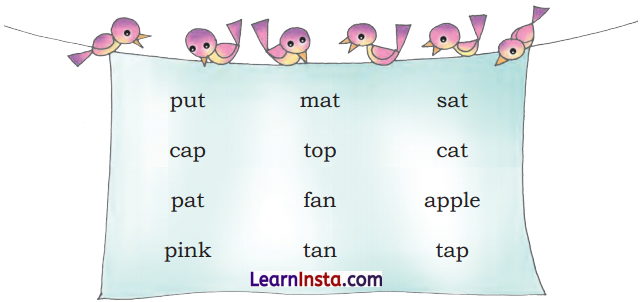
Answer:
་
B. Encircle the matching letters in each row.

Answer:

C. Match the words with the same initial syllable.

Answer:

Let us speak
Listen and Repeat
Some words have two syllables. Notice the words below:

Answer:
Read the words aloud.
![]()
Let us read



Answer:
Read the poem aloud.
Help the mouse reach its home.

Answer:

Let us listen
A. Close your eyes and listen to the words said by your teacher.

What is the first sound in each of these words?
Answer:
The first sound in ‘cat’ is C, in ‘bať’ is B, in ‘fat’ is F, in ‘sat’ is S, in ‘mat’ is M and in ‘hat ‘is H.
What is common in all these words?
Answer:
All these words have last two letters ‘at’.
B. Let us make words by adding one letter to ‘at’ as shown. The first has been done for you.

Answer:

C. Listen and do the actions that your teacher says:
- Catch the ball.
- Throw the ball.
- Hide under a table.
- Open your pencil box or bag.
- Close your pencil box or bag.
- Say hurray!!

Answer:
Do the action given for each situation.
D. Now listen to the following words. Do you know what they mean? Ask your teacher.

Answer:
- Catch – hold something with hand.
- Throw – move something away in the air from your hand.
- Hide – keep something at a place where no one can see it.
- Open – not surrounded by anything.
- Say – speak something to somebody by using words.
- Close – put something into a position so that it covers an opening.
Let us read
Try to read the story ‘Catch me if you can’ again by yourself.
Answer:
Read aloud the poem.
![]()
Let us do
What shall we make? A cat and a rat?
Look at the mask of a cat from the last page of your book.

- Now, think about the steps for making a mask of a rat. Tell your friends how to make a mask of a rat.
- Are your masks ready? Enact the story.
Answer:
Follow the instructions to make a cat.
Let us explore
Look at the insects, flowers, birds, animals, and trees around your home.
Draw some of these and tell your friends more about them.

Answer:
Learners can draw butterfly, rose, dog, cat, mango, tree, etc.
Let us do
A. Help these animals find their homes

Answer:

B. Ask anyone in your family to tell you a story about animals. Try to share the story in English in the class. Listen to the stories shared by your friends in class.
Answer:
Do it yourself.
C. In small groups, choose any story that you heard or shared in the class. Draw pictures for the story. Present the story in class.
Answer:
Do it yourself.
The Cap-seller and the Monkeys Class 1 Summary
The Cap-seller and the Monkeys Class 1 Summary in English
The chapter introduces the story of ‘The Cap-seller and the Monkeys’. It focuses on the words that start with same sounds. It also teaches the concept of singular and plural words. In this chapter, learners will learn about the words with same syllables.


The Cap-seller and the Monkeys Class 1 Summary in Hindi
यह अध्याय ‘टोपी-विक्रेता और बंदरों’ की कहानी के बारे में बताता है। यह अध्याय उन शब्दों पर केंद्रित हैं, जो समान ध्वनि के साथ शुरू होते हैं। यह एकवचन और बहुवचन शब्द की अवधारणा भी सिखाता है। इस अध्याय में शिक्षार्थी समान अक्षरों वाले शब्दों के बारे में सीखेंगे।

The Cap-seller and the Monkeys Class 1 Word Meanings
Let us read
1. Once there was a man who
sold caps. He carried many
caps in a basket on his head.
He was a cap-seller.
एक समय की बात है। एक व्यक्ति
टोपियाँ बेचता था। वह अपने सिर पर
एक टोकरी में कई
टोपियाँ रखकर उन्हें बेचता था।
Word Meanings:
- Basket (बास्केट ) -a container made of thin pieces of wood, plastic, etc., लकड़ी, प्लास्टिक आदि के पतले टुकड़ों से बनी एक टोकरी।
- Cap-seller (कैप-सेलर ) – one who sells caps, टोपी विकेता।
![]()
2. One day, he slept under a tree.
There were monkeys on the tree.
They came down from the tree.
They took away all the caps.
एक दिन वह एक पेड़ के नीचे सो गया
पेड़ पर बंदर थे।
वे पेड़ से नीचे उतरे।
उन्होंने सारी टोपियाँ निकालकर ले गए।
Word Meanings:
- Under (अंडर) – in a position that is below something, नीचे।
- Away (एवे) – at a particular distance from a place, दूर।
3. The cap-seller woke up.
He saw the basket was
empty! He looked around
and above. The monkeys
were wearing his caps.
टोपी बेचने वाला जाग गया।
उसने देखा कि टोकरी खाली है
खाली! उसने चारों तरफ़
और ऊपर की तरफ देखा।
बंदर उसकी टोपी पहने हुए थे।
Word Meanings:
- Empty (एम्पटी) – nothing inside, खाली, अंदर कुछ भी नहीं।
- Wear (वीयर) – to have clothes in our body, पहनना।
- Around (अराउंड) – in various places or directions, चारों ओर।
4. The cap-seller shook his fists at the monkeys.
They also did the same.
The cap-seller scratched his head.
The monkeys did the same.
टोपी बेचने वाले ने बंदरों पर अपनी मुट्ठियाँ तान दी
उन्होंने भी ऐसा ही किया।
टोपी बेचने वाले ने अपना सिर खुजलाया।
बंदरों ने भी ऐसा ही किया।
Word-Meanings:
- Fist (फिस्ट) – a hand with closed fingers, (मुट्ठी) बंद उँगलियों वाला हाथ।
- Scratch (स्कैच) – rub over skin with nails when it itches, खरोचना।
5. The cap-seller had an idea!
He took off his cap and threw it
into the empty basket.
The monkey also did the same.
The cap-seller got all his caps back and went away happily.
टोपी बेचने वाले को एक तरकीब सूझी!
उसने अपनी टोपी उतार कर
खाली टोकरी में फेंक दी
बंदरों ने भी ऐसा ही किया।
टोपी बेचने वाले ने अपनी सारी टोपियाँ वापस ले लीं और खुशी-खुशी चला गया।
Word Meanings:
- Idea (ऑइंडिया) – a plan, trick, (विचार) एक योजना, युक्ति।
- Same (सेम) – not different, ऐसा ही।
Butterflies
1. Butterflies, butterflies,
Up, up, up.
तितलियाँ, तितलियाँ
ऊपर, ऊपर, ऊपर।
Word Meanings:
- Butterfly (बटरफलाई) – insect with a colourful wings, तितली।
- Up (अप) at higher level, ऊपररा।
![]()
2. Butterflies, butterflies,
Down, down, down.
Butterflies, butterflies
In, in in.
Butterflies, butterflies
Out, out, out
तितलियाँ, तितलियाँ
नीचे, नीचे, नीचे।
तितलियाँ, तितलियाँ
अंदर, अंदर, अंदर।
तितलियाँ, तितलियाँ
अंदर, अंदर, अंदर।
Word Meanings:
- Down (डाउन) – at a lower level, नीचे।
- In (इन) – at a point within an area, अंदर।
Catch me if you can
1. A fat cat sat on a mat.
“I can catch you, little rat”, said the cat.
एक मोटी बिल्ली एक चटाई पर बैठी थी।
“मैं तुम्हें पकड़ सकती हूँ, छोटे चूहे”, बिल्ली ने कहा।
Word Meanings:
- Fat (फैट) – having too much flesh, मोटा।
- Catch (कैच) – to hold something that is moving with hands, पकड़ना।
- Mat (मैट) a piece of carpet that we put on the floor, चटाई।
2. A little rat saw her,
and hid in a hat.
“No, no, you cant’t”,
said the rat.
एक छोटे चूहे ने उसे देखा,
और एक टोपी में छुप गया।
“नहीं, नहीं, आप ऐसा नहीं कर सकती”
चूहे ने कहा.
Word-Meanings:
- Hid (हिड) – kept something in a place where it couldn’t be seen or found, छिपाया
- Hat (हैट) – a covering worn on head, टोपी।
3. The cat ran to catch the rat.
चूहे को पकड़ने के लिए दिल्ली दौड़ी।
Word-Meanings:
- Ran (रैन) – moved legs faster than a walk, दौड़ा।
![]()
4. The rat ran and hid in a box.
The lid of the box did not open.
“Ha, ha! You can’t catch me, big cat!” said the rat.
चूहा भागकर एक डिब्बे में छिप गया।
डिब्बे का ढक्कन नहीं खुला।
‘हा हा! तुम मुझे नहीं पकड़ सकती। बड़ी बिल्ली!’ चूहे ने कहा।
Word-Meanings:
- Lid (लिड) – the top part of a box, ढक्कन।
- Open (ओपन) – not closed or covered, खुला।
The Cap-seller and the Monkeys Class 1 Questions and Answers




